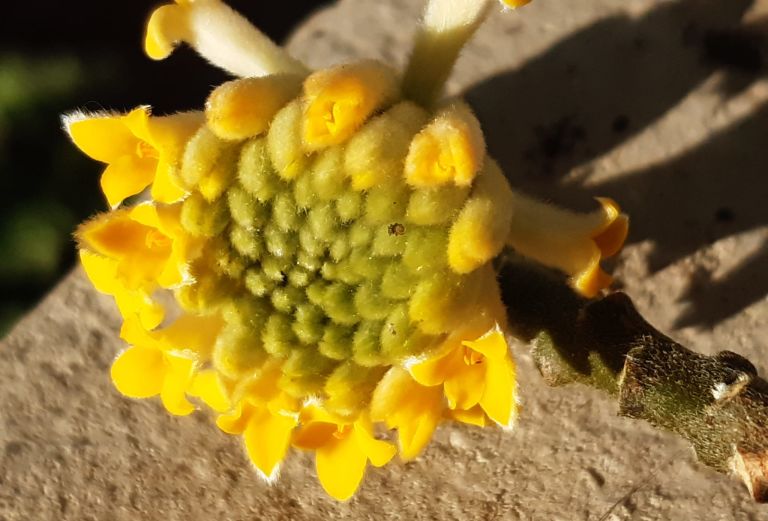
Written by Millie Woodley, garden apprentice.
Edgeworthia chrysantha, or oriental paperbush, is definitely worthy of being plant of the month this February. For much of the year, it’s a quiet shrub with dense stems of alternating leaves which drop for winter and reveal many tightly arranged leaf scars. In the cool air and morning frosts of early spring, it’s one of the first to burst into action, not with leaves, but with a stunning show of small clusters of golden-yellow flowers! It’s almost as if the leaves hold back for the flowers to take full attention. In February this year, Fulham Palace’s sole specimen is at its prime and can be easily spotted from afar in the walled garden on the right of the gates, leading to the woodland and Compton borders.
The species name chrysantha derives from the Greek chrysos meaning ‘golden’ and ‘anthos’ meaning flower. Edgeworthia chrysantha was named after Michael Pakenham Edgeworth (1812 – 1881), an amateur botanist and member of the Indian Civil Service from 1831 – 1881. Many plants Edgeworth collected on his travels in India, Aden (Yemen) and Sri Lanka, were named after him, such as Platanthera edgeworthii and Primula edgeworthii. Like many of the plant collectors of this era, Edgewrorth’s collecting is linked to colonialism.
It is used in folk medicine in China and is known as jie xiang (结香), where it grows natively. The bark and roots have anti-inflammatory and analgesic properties, and the flower buds are used to treat eye diseases. Its natural range includes southern and eastern China and Myanmar and it was introduced into Georgia, Japan and Korea.

It has been used by the Japanese since the 16th century, after it was introduced into cultivation, and is known as mitsumata (meaning ‘triple branching’, referencing its growth habit). Traditionally, the bark fibres are used for making the handmade Japanese tissue called mitsumata paper, and for making traditional Japanese paper and washi, amongst other uses. Its stems are incredibly flexible, due to the strong fibres.
Be sure to look for it next time you visit the walled garden. You can’t miss its bright beauty and the strong sweet scent!
The walled garden is open daily from 10.30 – 15.45.